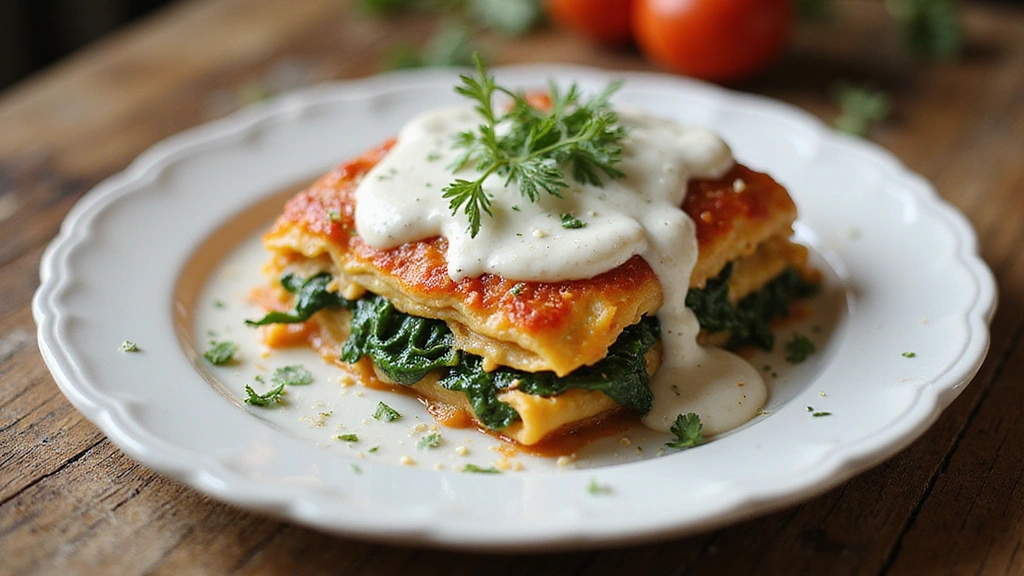There’s something uniquely comforting about a well-made chicken lasagna, especially when it’s layered with creamy white sauce and fresh spinach.
This dish combines the richness of tender chicken and the earthiness of spinach, culminating in a flavor profile that’s both hearty and sophisticated.
I first encountered this variation during a family gathering, where its heartwarming flavors brought everyone to the table with smiles.
Whether it’s a chilly autumn night or a festive occasion, this chicken lasagna with spinach and white sauce provides warmth and satisfaction.
Expect a dish that mingles tradition with a touch of modern elegance, perfect for any setting.
Once you try it, you’ll find it becomes a staple in your recipe collection.
The History and Cultural Significance
• Chicken Lasagna Recipe traces its origins to Italy, where it was originally created by home cooks adapting traditional lasagna to use locally available ingredients.
• The dish evolved over decades as cooks began incorporating white sauces and experimenting with different proteins, eventually becoming the beloved version we know today.
• In Italian culture, this dish traditionally appears at family gatherings and celebrations, symbolizing warmth and togetherness.
• While many variations exist across different regions, the authentic version maintains a balance of creamy sauce and fresh ingredients that sets it apart from imitations.
Recipe Overview
Nutritional Information (per serving)
Essential Equipment Guide
Baking Dish: A sturdy baking dish is essential for even cooking and achieving a perfectly layered lasagna. Look for one with high sides to prevent overflow, and consider alternatives like a deep skillet if necessary.
Whisk: A whisk is crucial for making a smooth and lump-free white sauce. If unavailable, a fork or an immersion blender can substitute, but ensure it’s heat-resistant if used directly in the pot.
Sharp Knife: A sharp knife ensures precise cuts of chicken and vegetables, which is important for even cooking and presentation. A chef’s knife is ideal, but any well-maintained, sharp kitchen knife will suffice.
Ingredients
For the Base
|
|
| Amount | Ingredient | Notes |
|---|---|---|
| 9 sheets | lasagna noodles | pre-cooked or no-boil for ease |
For the Sauce
| Amount | Ingredient | Notes |
|---|---|---|
| 4 tablespoons | butter | adds creaminess |
| 4 tablespoons | all-purpose flour | thickens the sauce |
| 3 cups | milk | provides a rich base |
| 1 cup | parmesan cheese | grated, for flavor and texture |
For the Chicken
| Amount | Ingredient | Notes |
|---|---|---|
| 2 cups | cooked chicken | shredded or diced |
Vegetables
| Amount | Ingredient | Notes |
|---|---|---|
| 3 cups | fresh spinach | washed and roughly chopped |
Seasonings
| Amount | Ingredient | Notes |
|---|---|---|
| 1 teaspoon | salt | enhances overall flavor |
| 1 teaspoon | black pepper | freshly ground, for mild heat |
| 1 teaspoon | nutmeg | adds warmth to the sauce |
Preparation Methods
Bechamel Sauce Preparation: This technique involves creating a white sauce by whisking flour into melted butter, then slowly incorporating milk. The key is to whisk constantly to prevent lumps and achieve a smooth consistency. Mastering this ensures a creamy, luxurious sauce that holds the lasagna together.
Layering Technique: Proper layering of ingredients is crucial for even cooking and flavor distribution. Start with a thin layer of sauce, followed by noodles, chicken, spinach, and more sauce. Repeat until ingredients are used up, finishing with sauce and cheese on top.
Spinach Wilting: Wilt spinach by gently heating it in a pan with a bit of olive oil until just softened. This technique reduces volume and intensifies flavor without overcooking, preserving nutrients and color.
Step 1: Prepare the Sauce

Melt the butter in a saucepan over medium heat.
Add the flour and whisk continuously to form a roux.
Gradually pour in the milk, whisking constantly to avoid lumps.
Continue stirring until the sauce thickens and coats the back of a spoon.
Step 2: Cook the Spinach

Heat a small amount of olive oil in a pan over medium heat.
Add the chopped spinach and sauté until just wilted.
Remove from heat and set aside to cool slightly.
Ensure the spinach retains a bright green color.
Step 3: Shred the Chicken

Use two forks to shred the cooked chicken into bite-sized pieces.
Alternatively, dice the chicken if preferred.
Ensure all pieces are roughly the same size for even distribution.
Set aside in a bowl for layering.
Step 4: Preheat the Oven

Preheat your oven to 375°F (190°C).
Ensure the oven is fully heated before placing the lasagna inside.
This ensures even cooking and proper browning.
Adjust racks if necessary to fit the baking dish comfortably.
Step 5: Assemble the Lasagna

Spread a thin layer of white sauce on the bottom of the baking dish.
Place a layer of lasagna noodles over the sauce.
Add a layer of shredded chicken and wilted spinach.
Repeat layers, finishing with sauce and a generous sprinkle of parmesan cheese.
Step 6: Bake the Lasagna

Cover the assembled lasagna with aluminum foil.
Place in the preheated oven and bake for 40 minutes.
Remove the foil and bake for an additional 20 minutes to brown the top.
Look for bubbling edges and a golden cheese topping.
Step 7: Rest the Lasagna

Remove the lasagna from the oven and let it rest for at least 10 minutes.
This allows the layers to set and makes slicing easier.
Cover loosely with foil to keep warm if necessary.
Ensure the dish is on a heat-resistant surface during resting.
Step 8: Serve and Enjoy

Slice the lasagna into portions using a sharp knife.
Use a spatula to transfer slices to plates gently.
Garnish with fresh basil leaves for added color and aroma.
Serve hot, with a side salad or garlic bread if desired.
Critical Timing and Temperature Guide
Sauce Cooking: Cook the sauce over medium heat for 10 minutes, stirring constantly until thickened. Avoid high heat to prevent scorching, and ensure the sauce coats the back of a spoon.
Oven Baking: Bake at 375°F for 60 minutes total, checking after 40 minutes to remove the foil. Look for golden brown cheese and bubbling edges as indicators of doneness.
Resting Period: Allow the lasagna to rest for at least 10 minutes after baking. This helps the layers firm up and makes slicing cleaner, avoiding a soupy texture.
Pro Tips for Chicken Lasagna Recipe
• Ingredient Selection: Choose high-quality parmesan cheese and fresh spinach to elevate flavor and texture; these ingredients make the biggest difference.
• Preparation Secret: Toast the flour gently before adding milk for a deeper, nuttier flavor in the white sauce.
• Temperature Management: Ensure milk is at room temperature before adding to the roux to prevent clumping in the sauce.
• Texture Enhancement: Layering technique is crucial; don’t overfill with sauce to maintain structure and prevent sogginess.
• Flavor Layering: Use freshly ground nutmeg in the sauce to add warmth and complexity, enhancing the overall flavor profile.
• Make-Ahead Strategies: Assemble the lasagna a day ahead and refrigerate. Allow it to come to room temperature before baking to ensure even cooking.
• Restaurant-Quality Finishing Touches: Finish with a sprinkle of fresh herbs like basil or parsley just before serving for a burst of freshness.
• Equipment Optimization: Use a mandoline to uniformly slice vegetables if you include additional layers, ensuring even cooking.
Troubleshooting Common Issues
• Sauce Too Lumpy: This occurs if the flour isn’t fully incorporated into the butter before adding milk. Strain the sauce through a fine sieve or blend it to smooth it out.
• Lasagna Not Setting: If the layers are too wet, reduce the amount of sauce or add a layer of breadcrumbs to absorb excess moisture.
• Burnt Cheese Top: If the cheese browns too quickly, cover with foil earlier or move to a lower oven rack.
• Undercooked Noodles: Ensure noodles are fully submerged in sauce layers to cook evenly. Use pre-cooked or no-boil noodles to avoid this issue.
• Uneven Cooking: Rotate the baking dish halfway through cooking if your oven has hot spots, ensuring even heat distribution.
Variations and Regional Differences
• Italian Region Variation: In certain Italian regions, ricotta is added to the layers for extra creaminess, and nutmeg is more prominently featured in the bechamel sauce.
• American Style: Often includes additional vegetables like mushrooms and bell peppers for added flavor and nutrition.
• Middle Eastern Twist: Incorporates spices like cumin and coriander for a unique flavor profile, and sometimes uses yogurt in place of part of the white sauce.
• Vegetarian Version: Replaces chicken with a mix of roasted vegetables such as zucchini and eggplant, maintaining the same sauce and noodles.
Food Science Behind the Recipe
• Maillard Reaction: The browning of the cheese on top is a result of the Maillard reaction, which enhances flavor through the caramelization of proteins and sugars.
• Starch Gelatinization: Flour in the sauce thickens through gelatinization, where starch granules absorb liquid and expand, creating a creamy consistency.
• Protein Denaturation: Cooking chicken and cheese involves protein denaturation, changing their structure for tenderness and flavor development.
Frequently Asked Questions
What's the most common mistake people make when preparing chicken lasagna? Overloading with sauce can lead to a soupy lasagna, so be conservative with sauce layers.
Can I use gluten-free noodles? Yes, gluten-free noodles work well, but ensure they are fully coated in sauce to avoid dryness.
How can I make this dish ahead of time? Assemble the lasagna and refrigerate for up to 24 hours, then bake as directed.
What’s the best way to reheat leftovers? Cover and bake in a 350°F oven until heated through, or microwave individual portions.
Why is my lasagna watery? Watery lasagna may result from too much sauce or not resting long enough after baking.
Can I freeze this lasagna? Yes, freeze before or after baking. Thaw overnight in the refrigerator before reheating.
What can I do if I don’t have parmesan cheese? Substitute with romano or asiago cheese for a similar taste and texture.
Serving and Presentation Guide
• Traditional Presentation: Serve on a white plate to highlight the lasagna’s colors, garnished with a sprig of fresh basil.
• Family-Style: Present in the baking dish, allowing guests to serve themselves, enhancing the communal dining experience.
• Gourmet Twist: Plate with a drizzle of balsamic reduction and a side of arugula salad for a refined touch.
• Casual Buffet: Slice into squares and arrange on a platter for easy serving at casual gatherings.
Conclusion
This Chicken Lasagna with Spinach and White Sauce offers a delightful blend of flavors and textures, perfect for any occasion.
With its straightforward preparation and impressive results, it's a recipe worth adding to your culinary repertoire.
Gather your ingredients, follow the steps, and enjoy a homemade dish that’s sure to become a family favorite.

